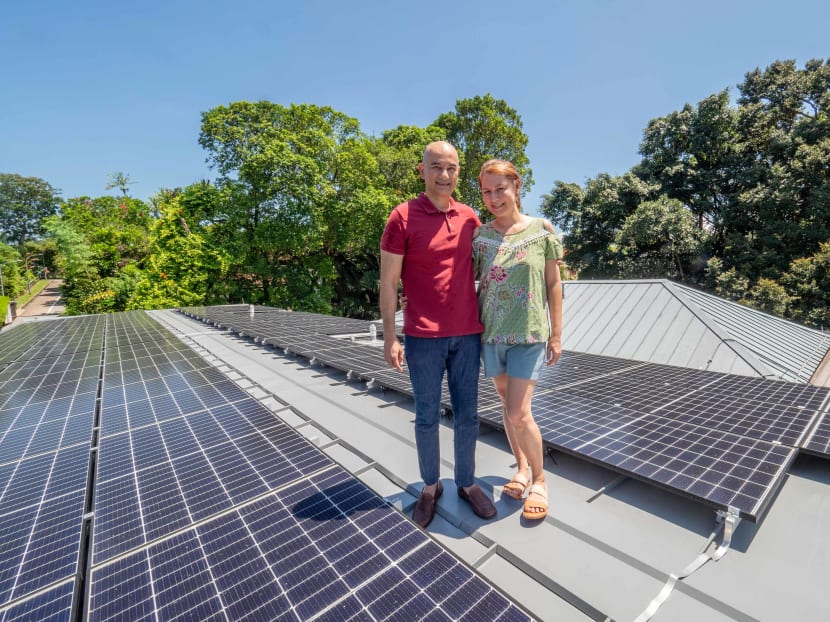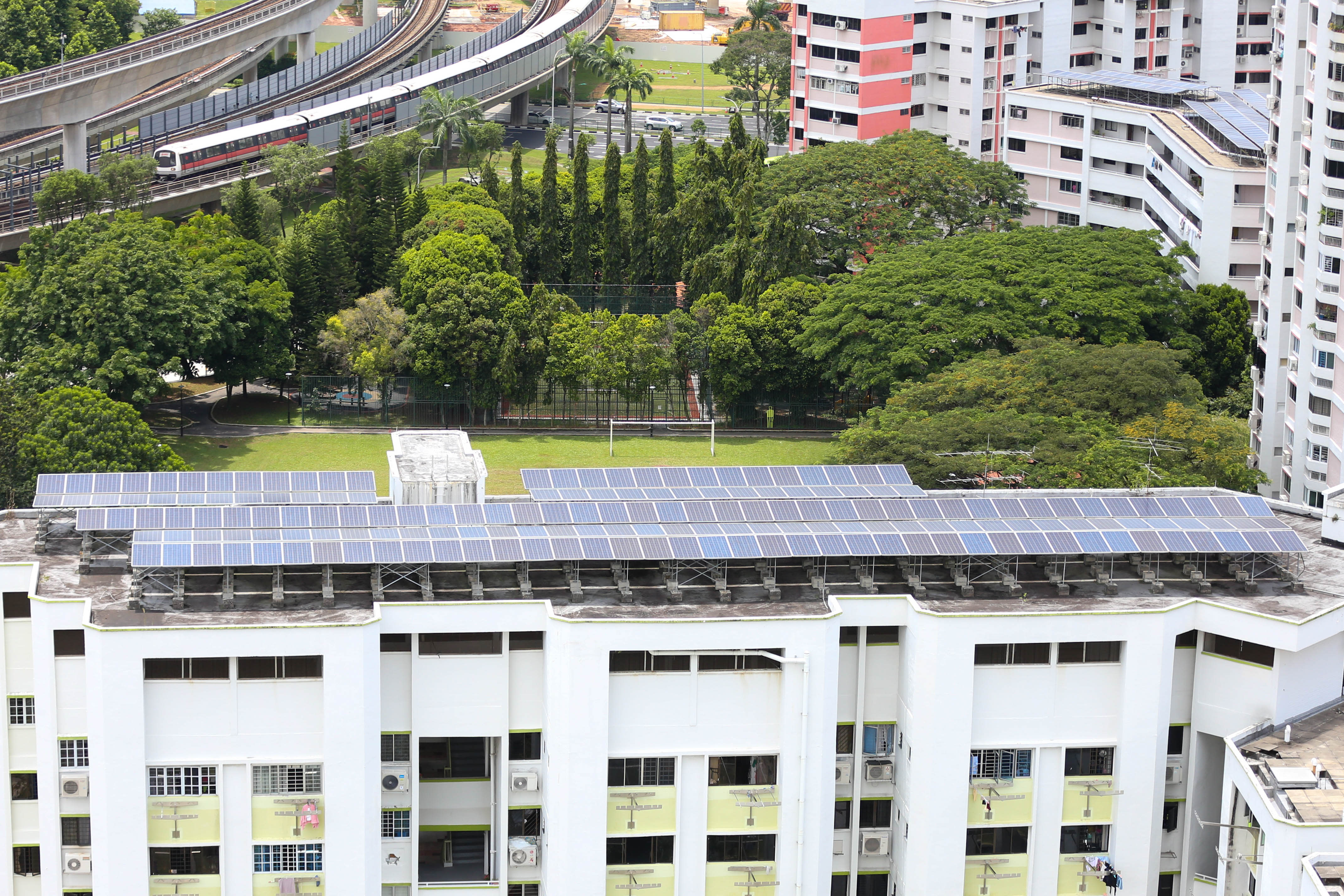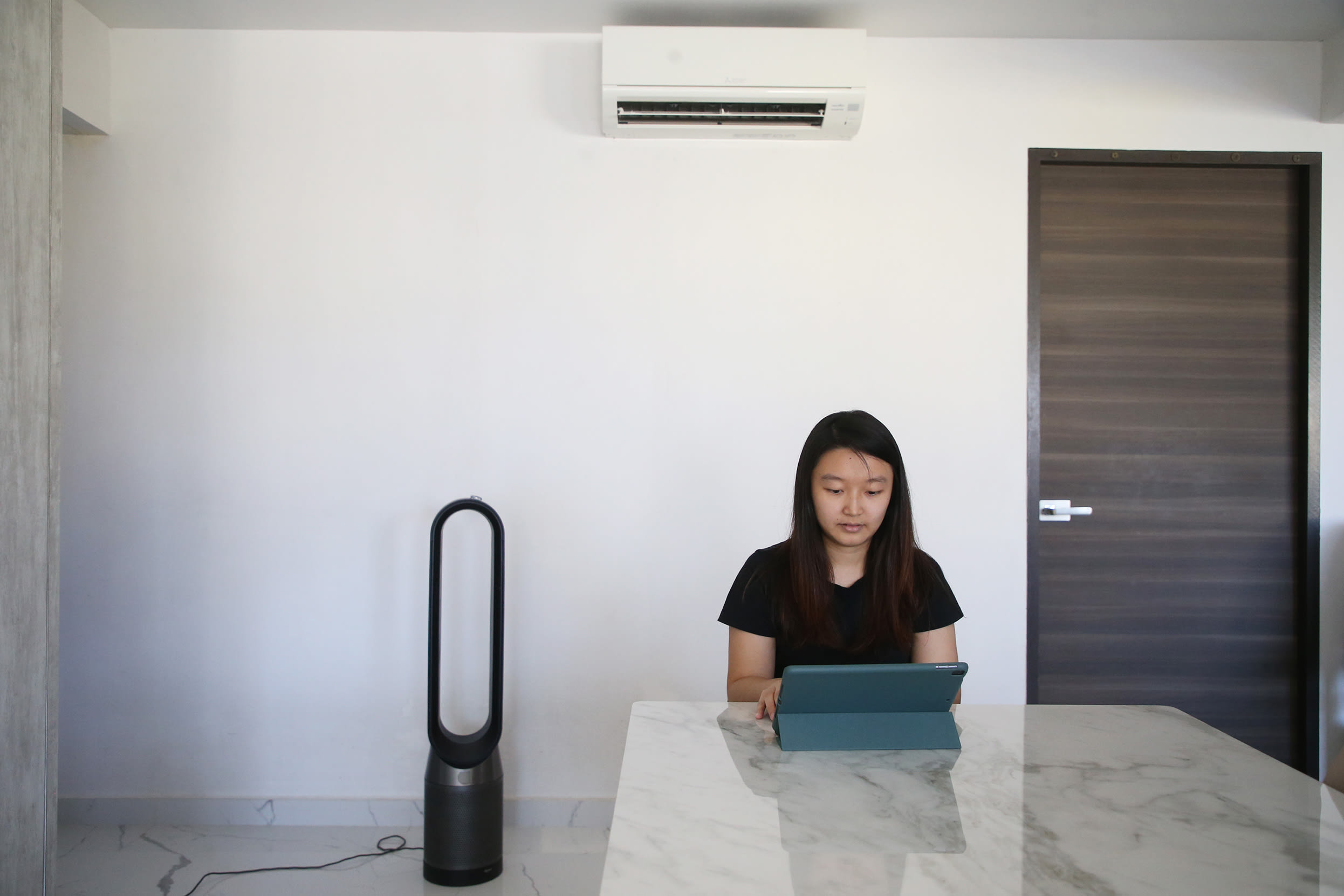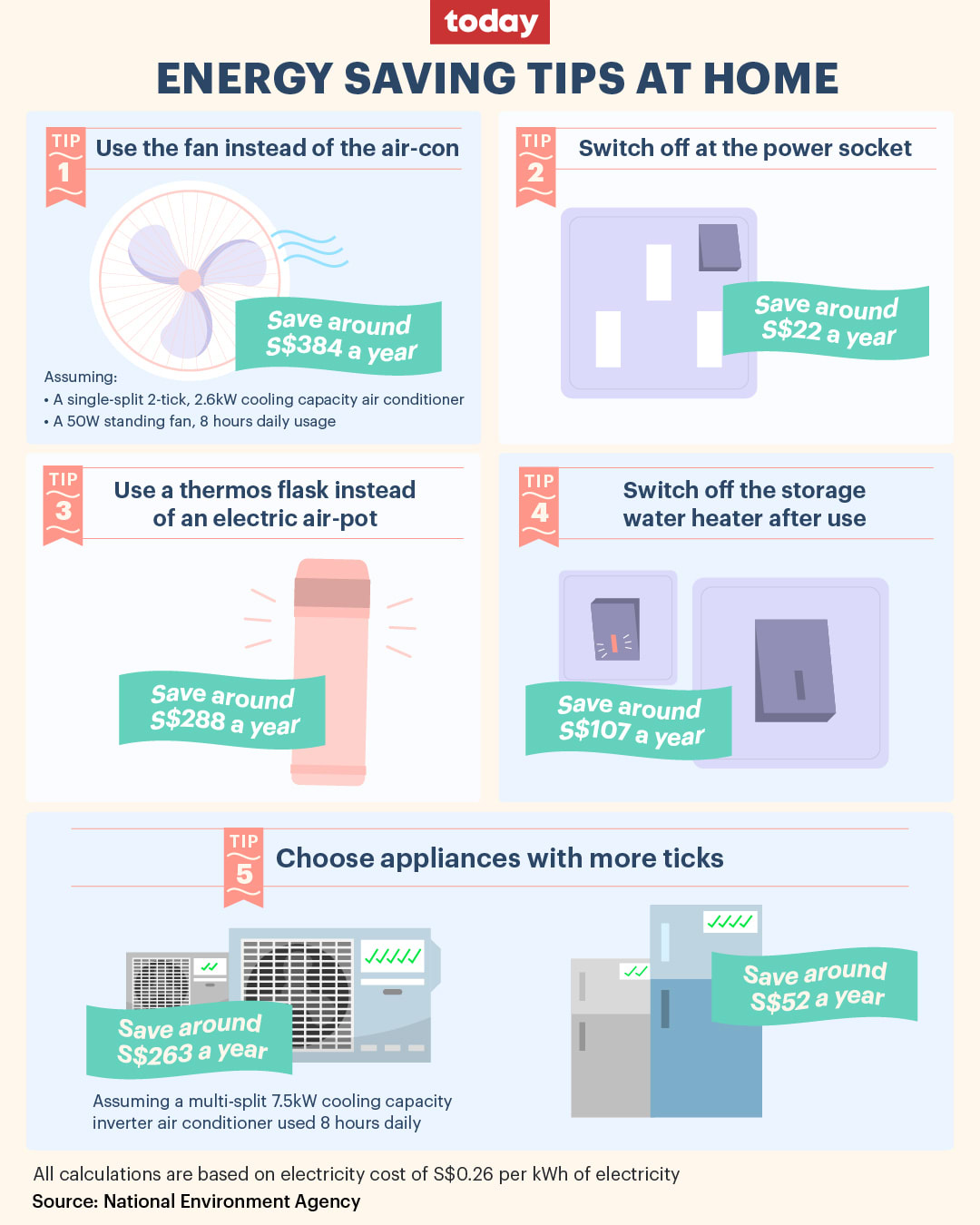The Big Read in short: Amid higher electricity bills, going green means saving money too
Each week, TODAY’s long-running Big Read series delves into the trends and issues that matter. This week, we look at how amid rising electricity costs, households can trim their electricity bills and be eco-friendly at the same time. This is a shortened version of the full feature, which can be found here.

Mr Arun Murthy and his wife, Mrs Sheryl Arun Murthy, pose for a photo on May 12, 2022. In March this year, 100 solar panels were installed on the roof of their house.
Each week, TODAY’s long-running Big Read series delves into the trends and issues that matter. This week, we look at how amid rising electricity costs, households can trim their electricity bills and be eco-friendly at the same time. This is a shortened version of the full feature, which can be found here.
- Earlier this month, in his May Day Rally speech, Prime Minister Lee Hsien Loong spoke about the impact of soaring energy prices on Singapore and its people
- The increase in electricity prices is due to a confluence of factors, such as the Russia-Ukraine war, Singapore’s lack of alternatives for electricity and rising demand for electricity as the world recovers from the Covid-19 pandemic
- With electricity costs expected to continue rising for at least a year, Singapore’s move towards greener energy sources has become more important than ever, some experts said
- Solar panel sellers said they have seen an increase in enquiries as households look to generate their own electricity instead
- Given the limitations on tapping solar energy especially among HDB dwellers, what are other ways for households to not only do their part for the environment but also go easy on their wallets?
SINGAPORE — Whenever the sun is blazing, Mr Arun Murthy gets excited, as a mobile application on his phone would show that his house is generating more electricity than it is using.
In mid-March, he installed 100 solar panels on the roof of his landed property in Bukit Timah.
Since then, the family’s monthly electricity bill has dropped from about S$1,200 to about S$370. Apart from meeting some of the house's energy needs, the solar panels also generate excess electricity during the day that is sold back to Singapore’s power grid system operated by SP Group.
“Every month, we get a cheque from SP Group for selling our excess electricity, which we can use to offset our electricity bill from a private retailer… We have reduced our dependency on the grid by about 70 per cent,” said the 54-year-old chief executive officer of cybersecurity firm Invisiron.
As the family does not have a battery system to store excess electricity generated, the solar panels only fuel the house’s electricity needs when the sun is out in the day. On rainy days and at night, the home relies on the national energy grid.
While installing the S$54,000 solar panels has meant lower electricity bills for the family, Mr Murthy said that the "primary reason" for doing so was to do his part for the environment.
Another reason was to rely less on natural gas — regarded as the cleanest form of fossil fuel and is used to generate 95 per cent of Singapore’s electricity supply, but whose prices have skyrocketed recently amid a global energy crunch.
Singapore’s electricity tariffs for April 1 to June 30 increased from the preceding quarter by around 9.8 per cent to S$0.27 per kilowatt hour (kWh), excluding Goods and Services Tax.
Earlier this month, in his May Day Rally speech, Prime Minister Lee Hsien Loong spoke about the soaring energy prices, which will set the country back by about S$8 billion a year, as he warned that Singapore must be prepared for more economic challenges ahead.
The increase in electricity prices is due to a confluence of factors, such as the Russia-Ukraine war, Singapore’s lack of alternatives for electricity and rising demand for electricity as the world recovers from the Covid-19 pandemic, experts told TODAY.

And with electricity costs expected to continue rising for at least a year, Singapore’s move towards greener energy sources has become more important than ever, some of the experts added.
Indeed, by reducing electricity consumption or turning to renewable energy, households now can not only do their part to save the Earth — but also go easy on their wallets.
FACTORS DRIVING THE SURGE IN ELECTRICITY PRICES
One reason for the rising electricity tariffs for the past two years is that 95 per cent of electricity in Singapore is generated by natural gas, a byproduct of crude oil, said Associate Professor Chang Young Ho, head of the business and management minor at the Singapore University of Social Sciences (SUSS).
Recovery from Covid-19 has also increased energy demand from industries, while the Ukraine-Russia war has affected oil prices, resulting in the hike, he said.
Dr David Broadstock, a senior research fellow and the head of the Energy Economics Division at the National University of Singapore's (NUS) Energy Studies Institute, said the decision by Europe and other countries to stop purchasing natural gas from Russia has forced them to search for new gas suppliers.
“At the same time, there are limits to how much gas supply chains can scale up without major new infrastructure development, which would also take some years to provide.
“This is a perfect recipe for natural price increases for natural gas, as those countries which are willing and able to pay higher prices may choose to do so to ensure a secure energy supply,” said Dr Broadstock.
He also noted that China’s demand for natural gas has been consistently growing as it searches for a cleaner fuel option as compared to coal. This is especially so during the winter season, which has created long-term pressure on markets.
Electricity prices would take about a year to stabilise, experts estimated.
On April 4, Second Minister for Trade and Industry Tan See Leng spoke in Parliament about mechanisms to help Singapore stabilise prices and ensure sufficient supply, such as a standby liquefied natural gas facility and requirements imposed on power generation companies.
They were introduced after "upstream production issues in Indonesia’s West Natuna gas field and gas pressure issues from South Sumatra in the fourth quarter of 2021 caused disruptions to our piped natural gas supplies," said Dr Tan, who is also Manpower Minister.
EMA has also modified market rules, allowing the agency to direct power generation companies to use gas from its standby facility, to manage the cost impact on consumers.
However, experts said that the prices and impact on supply reinforce the need for Singapore to diversify its energy sources and improve its local production — which currently makes up just 5 per cent of the country’s energy supply.
VIABILITY OF SOLAR ENERGY FOR HOUSEHOLDS
Some households looking to cut their electricity bills without changing too much of their lifestyles can generate their own electricity via solar power, which is the main renewable energy option here.
Professor Subodh Mhaisalkar, executive director of NTU’s Energy Research Institute, noted that solar panel technology has advanced over the years, reaching efficiencies of between 20 to 22 per cent. This efficiency refers to the amount of electricity generated from solar energy that falls on the panel.
Solar panel installation companies told TODAY that they have seen increased interest in their services this year, with more homes looking to do their part for the environment while saving money.

Mr Satish Prasath, founder and director of PMCE (Global), said his company used to receive about one enquiry a day for its residential services when it first started in December 2017, but that has increased to three queries daily this year.
The company has since outfitted 300 residential homes with solar panels. On average, households spend between S$18,000 and S$22,000, and the average home installs 30 panels. This would equate to about S$300 to S$400 saved a month, Mr Prasath estimated.
“People are concerned about the impact of the Ukraine-Russia war so they are looking for long-term solutions,” he said.
The panels have a warranty of 25 to 30 years, so homeowners stand to profit from installing them, he added.
“The (solar) energy generated is often more than the household consumption, so when they sell to the grid, some of our customers even get negative utility bills each month because they’re owed money.Mr Benedict Goh, chief investment officer of renewable energy firm UTICA”
Mr Benedict Goh, chief investment officer of UTICA, said another draw of solar panels today is the increased efficiency and return on investment.
“When we started selling goods related to solar panels in 2004, costs were much higher and the return on investment was around 10 to 15 years… but now, it's more efficient and costs have dropped by half of what they were in early 2010,” he said.
“The energy generated is often more than the household consumption, so when they sell to the grid, some of our customers even get negative utility bills each month because they’re owed money,” he said, adding it can save customers between 40 and 80 per cent of their monthly consumption bills.
However, while solar energy may provide future cost-savings, it has its own limitations.
For one, households still need to rely on electricity from natural gas as solar panels generate electricity only during the day. Dr Broadstock noted that many households’ demand for electricity increases at night when people are back from work.
And while they can combine solar power with chargeable batteries, Dr Broadstock said battery technologies can be unsafe, which makes their use in residential and high-density urban environments like Singapore “challenging”.
The installation of solar panels is also subject to a building's structural limitations, be it for a landed property or a HDB flat.
According to the Building Construction Authority's (BCA) handbook for solar photovoltaic systems, there are constraints whereby standard development control guidelines apply.
Apart from possibly requiring an electrical installation license, BCA said in its handbook that existing buildings may require a professional structural engineer to carry out an inspection of the roof structure and calculate the structural loading.
"If the roof is unable to withstand the loading of the solar photovoltaic system, structural plans will need to be submitted to BCA for approval before a building permit can be issued for commencement of installation works," the authority said.
It also noted that the solar panels are exposed to the threat of lightning strikes and hence, require proper lightning protection.
There are also different challenges with outfitting landed properties, condominiums and HDB flats with solar panels, such as getting appropriate approvals and having enough space to install the panels.
While HDB residents are limited by space constraints and the amount of sunlight received, smaller solar generators are available on the market to charge electronics like mobile phones.
As part of a Government initiative to harness solar energy, HDB has to date installed solar panels on about 2,700 blocks and plans to reach 8,400 blocks in the next “two to three years”. In total, this will produce enough electricity to power 95,000 four-room flats.
On how these panels will benefit residents, the Ministry of National Development (MND) said in a written parliamentary reply on Jan 10 that the energy generated is "first used to power common services in HDB estates, such as lifts and lights", and any excess solar energy will be channeled to the national grid.
"Town Councils managing these HDB blocks will enter into a service agreement with the solar vendor to pay for the solar energy consumed, at a preferential rate not higher than the retail electricity tariff rate," MND added. "This may help the Town Councils in mitigating the rising cost of energy."
HOW TO SAVE ON ELECTRICITY BILLS
For now, there remain significant limitations as to how individual households can turn to renewable energy as an alternative power source.
Nevertheless, consumers can still take matters into their own hands, in terms of reducing their electricity consumption.
For example, Ms Valerie Khoo, a 27-year-old wealth management consultant, said she does not use a fan or air-conditioner on cooler days but instead, leaves her windows open at night while she sleeps.
"With the (electricity) price increase, we've been a bit more conscious and my mom nags at us more about not using the air conditioner unless its really too hot," she said.
Her family of four spends about S$120 a month on electricity for their five-room flat. Apart from ensuring they turn off the lights when not in use, they also chose a two-tick refrigerator — the highest energy rating available for her nearly 650 litre fridge when it was bought in 2018.
The ticks system by the National Environment Agency (NEA) rates the energy efficiency of household appliances, with five ticks being the most efficient, and one tick being the least efficient. This is displayed on the energy label, which also shows consumers the annual energy cost of the appliance.

Like some other consumers whom TODAY spoke to, Ms Khoo said her electricity-saving habits have been shaped over the years, motivated by a desire to not just reduce her electricity bill but also to reduce her carbon footprint.
“By using energy-efficient appliances and adopting good energy consumption habits, households will enjoy lower utility bills whilst contributing towards climate action.National Environment Agency”
Mr Tan Tsiat Siong, lecturer at SUSS’ School of Business, said households should not just replace damaged appliances with more energy-efficient ones but do so with their older appliances to benefit from long-term savings.
He added that the simple actions of turning off switches when not in use, not leaving chargers on when devices are fully charged, and unplugging cords when not in use, can help reduce electricity consumption.
Likewise, Prof Mhaisalkar from NTU’s Energy Research Institute said homeowners can minimise energy losses through simple steps like ensuring their windows are sealed well when using an air conditioner or relying on natural ventilation instead.
Dr Broadstock from NUS' Energy Studies Institute suggested setting the timer on appliances such as water heaters to help eliminate unnecessary energy consumption.
Households should also watch out for appliances with standby modes, which he dubs as “electricity vampires”.
“These constantly ‘suck’ a little energy from the socket even when on standby... Turning these off when they are not being used will help to reduce some power consumption," he said.
Responding to TODAY's queries, NEA noted that small habits can help reduce electricity costs — for example, simply using a fan instead of an air-conditioner can save households around S$384 a year based on electricity tariffs of S$0.26 per kWh.
“By using energy-efficient appliances and adopting good energy consumption habits, households will enjoy lower utility bills whilst contributing towards climate action,” the agency said.
To help inform consumers' purchasing decisions, NEA said they can use its online Life Cycle Cost Calculator to check yearly energy costs and compare these with upfront costs for electrical appliances.
NEA also said its "enforcement checks" at retail outlets have shown that there are appliances with higher ticks that are not more expensive than those with lower ticks.
“With rising electricity prices, the higher cost of a more energy-efficient appliance can be quickly recouped and the owner saves even more over the appliance’s lifespan,” it said.
Under the Climate Friendly Households Programme, one-, two- and three-room HDB households can register for S$225 worth of e-vouchers to offset the purchase price of resource-efficient appliances, NEA said.
Nevertheless, consumers can do more beyond opting for appliances that are more energy-efficient, experts said.












